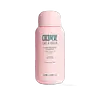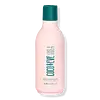What's inside
What's inside
 Key Ingredients
Key Ingredients

 Benefits
Benefits

 Concerns
Concerns

 Ingredients Side-by-side
Ingredients Side-by-side

Water
Skin ConditioningSodium Laureth Sulfate
CleansingCocamidopropyl Betaine
CleansingGlycerin
HumectantDecyl Glucoside
CleansingDisodium Capryloyl Glutamate
CleansingSodium Gluconate
Skin ConditioningTetrasodium Glutamate Diacetate
Phytic Acid
Hibiscus Sabdariffa Flower Extract
Skin ConditioningAcetum
Cocos Nucifera Fruit
AbrasiveLeuconostoc/Radish Root Ferment Filtrate
AntimicrobialCitric Acid
BufferingSorbitan Caprylate
Emulsifying1,2-Hexanediol
Skin ConditioningPotassium Sorbate
PreservativePropylene Glycol
HumectantSodium Chloride
MaskingSodium Benzoate
MaskingBenzyl Alcohol
PerfumingCitrus Limon Peel Extract
EmollientParfum
MaskingLimonene
PerfumingLinalool
PerfumingWater, Sodium Laureth Sulfate, Cocamidopropyl Betaine, Glycerin, Decyl Glucoside, Disodium Capryloyl Glutamate, Sodium Gluconate, Tetrasodium Glutamate Diacetate, Phytic Acid, Hibiscus Sabdariffa Flower Extract, Acetum, Cocos Nucifera Fruit, Leuconostoc/Radish Root Ferment Filtrate, Citric Acid, Sorbitan Caprylate, 1,2-Hexanediol, Potassium Sorbate, Propylene Glycol, Sodium Chloride, Sodium Benzoate, Benzyl Alcohol, Citrus Limon Peel Extract, Parfum, Limonene, Linalool
Water
Skin ConditioningSodium C14-16 Olefin Sulfonate
CleansingSodium Methyl Cocoyl Taurate
CleansingCetyl Betaine
CleansingSodium Cocoamphoacetate
CleansingLauryl Glucoside
CleansingGlycerin
HumectantCocos Nucifera Oil
MaskingAnanas Sativus Fruit Extract
Skin ConditioningNephelium Lappaceum Branch/Fruit/Leaf Extract
Skin ConditioningHydrolyzed Hyaluronic Acid
HumectantArgania Spinosa Kernel Oil
EmollientFicus Carica Fruit Extract
HumectantPersea Gratissima Oil
Skin ConditioningHydrolyzed Pea Protein
EmollientSapindus Trifoliatus Fruit Extract
Skin ConditioningSodium Hyaluronate
HumectantCocos Nucifera Fruit Juice
EmollientCocos Nucifera Water
MaskingPsidium Guajava Fruit Extract
AstringentPhospholipids
Skin ConditioningGlycol Distearate
EmollientPolyquaternium-22
Sodium Cocoyl Glutamate
CleansingSodium Lauryl Glucose Carboxylate
CleansingSodium Stearoyl Lactylate
EmulsifyingGlyceryl Caprylate
EmollientGlyceryl Stearate
EmollientPropanediol
SolventCetearyl Alcohol
EmollientTetrasodium Glutamate Diacetate
Glyceryl Undecylenate
EmollientPolyglyceryl-10 Dioleate
EmulsifyingPolyglyceryl-10 Oleate
Skin ConditioningGuar Hydroxypropyltrimonium Chloride
Skin ConditioningCocamidopropyl Betaine
CleansingLaureth-4
EmulsifyingAcrylates/C10-30 Alkyl Acrylate Crosspolymer
Emulsion StabilisingSodium Benzoate
MaskingPotassium Sorbate
PreservativeParfum
MaskingBenzyl Salicylate
PerfumingCoumarin
PerfumingLinalool
PerfumingCitric Acid
BufferingWater, Sodium C14-16 Olefin Sulfonate, Sodium Methyl Cocoyl Taurate, Cetyl Betaine, Sodium Cocoamphoacetate, Lauryl Glucoside, Glycerin, Cocos Nucifera Oil, Ananas Sativus Fruit Extract, Nephelium Lappaceum Branch/Fruit/Leaf Extract, Hydrolyzed Hyaluronic Acid, Argania Spinosa Kernel Oil, Ficus Carica Fruit Extract, Persea Gratissima Oil, Hydrolyzed Pea Protein, Sapindus Trifoliatus Fruit Extract, Sodium Hyaluronate, Cocos Nucifera Fruit Juice, Cocos Nucifera Water, Psidium Guajava Fruit Extract, Phospholipids, Glycol Distearate, Polyquaternium-22, Sodium Cocoyl Glutamate, Sodium Lauryl Glucose Carboxylate, Sodium Stearoyl Lactylate, Glyceryl Caprylate, Glyceryl Stearate, Propanediol, Cetearyl Alcohol, Tetrasodium Glutamate Diacetate, Glyceryl Undecylenate, Polyglyceryl-10 Dioleate, Polyglyceryl-10 Oleate, Guar Hydroxypropyltrimonium Chloride, Cocamidopropyl Betaine, Laureth-4, Acrylates/C10-30 Alkyl Acrylate Crosspolymer, Sodium Benzoate, Potassium Sorbate, Parfum, Benzyl Salicylate, Coumarin, Linalool, Citric Acid
 Reviews
Reviews

Ingredients Explained
These ingredients are found in both products.
Ingredients higher up in an ingredient list are typically present in a larger amount.
Citric Acid is an alpha hydroxy acid (AHA) naturally found in citrus fruits like oranges, lemons, and limes.
Like other AHAs, citric acid can exfoliate skin by breaking down the bonds that hold dead skin cells together. This helps reveal smoother and brighter skin underneath.
However, this exfoliating effect only happens at high concentrations (20%) which can be hard to find in cosmetic products.
Due to this, citric acid is usually included in small amounts as a pH adjuster. This helps keep products slightly more acidic and compatible with skin's natural pH.
In skincare formulas, citric acid can:
While it can provide some skin benefits, research shows lactic acid and glycolic acid are generally more effective and less irritating exfoliants.
Most citric acid used in skincare today is made by fermenting sugars (usually from molasses). This synthetic version is identical to the natural citrus form but easier to stabilize and use in formulations.
Read more about some other popular AHA's here:
Learn more about Citric AcidCocamidopropyl Betaine is a fatty acid created by mixing similar compounds in coconut oil and dimethylaminopropylamine, a compound with two amino groups.
This ingredient is a surfactant and cleanser. It helps gather the dirt, pollutants, and other impurities in your skin to be washed away. It also helps thicken a product and make the texture more creamy.
Being created from coconut oil means Cocamidopropyl Betaine is hydrating for the skin.
While Cocamidopropyl Betaine was believed to be an allergen, a study from 2012 disproved this. It found two compounds in unpure Cocamidopropyl Betaine to be the irritants: aminoamide and 3-dimethylaminopropylamine. High-grade and pure Cocamidopropyl Betaine did not induce allergic reactions during this study.
Learn more about Cocamidopropyl BetaineGlycerin is already naturally found in your skin. It helps moisturize and protect your skin.
A study from 2016 found glycerin to be more effective as a humectant than AHAs and hyaluronic acid.
As a humectant, it helps the skin stay hydrated by pulling moisture to your skin. The low molecular weight of glycerin allows it to pull moisture into the deeper layers of your skin.
Hydrated skin improves your skin barrier; Your skin barrier helps protect against irritants and bacteria.
Glycerin has also been found to have antimicrobial and antiviral properties. Due to these properties, glycerin is often used in wound and burn treatments.
In cosmetics, glycerin is usually derived from plants such as soybean or palm. However, it can also be sourced from animals, such as tallow or animal fat.
This ingredient is organic, colorless, odorless, and non-toxic.
Glycerin is the name for this ingredient in American English. British English uses Glycerol/Glycerine.
Learn more about GlycerinLinalool is a fragrance and helps add scent to products. It's derived from common plants such as cinnamon, mint, citrus, and lavender.
Like Limonene, this ingredient oxidizes when exposed to air. Oxidized linalool can cause allergies and skin sensitivity.
This ingredient has a scent that is floral, spicy tropical, and citrus-like.
Learn more about LinaloolParfum is a catch-all term for an ingredient or more that is used to give a scent to products.
Also called "fragrance", this ingredient can be a blend of hundreds of chemicals or plant oils. This means every product with "fragrance" or "parfum" in the ingredients list is a different mixture.
For instance, Habanolide is a proprietary trade name for a specific aroma chemical. When used as a fragrance ingredient in cosmetics, most aroma chemicals fall under the broad labeling category of “FRAGRANCE” or “PARFUM” according to EU and US regulations.
The term 'parfum' or 'fragrance' is not regulated in many countries. In many cases, it is up to the brand to define this term.
For instance, many brands choose to label themselves as "fragrance-free" because they are not using synthetic fragrances. However, their products may still contain ingredients such as essential oils that are considered a fragrance by INCI standards.
One example is Calendula flower extract. Calendula is an essential oil that still imparts a scent or 'fragrance'.
Depending on the blend, the ingredients in the mixture can cause allergies and sensitivities on the skin. Some ingredients that are known EU allergens include linalool and citronellol.
Parfum can also be used to mask or cover an unpleasant scent.
The bottom line is: not all fragrances/parfum/ingredients are created equally. If you are worried about fragrances, we recommend taking a closer look at an ingredient. And of course, we always recommend speaking with a professional.
Learn more about ParfumPotassium Sorbate is a preservative used to prevent yeast and mold in products. It is commonly found in both cosmetic and food products.
This ingredient comes from potassium salt derived from sorbic acid. Sorbic acid is a natural antibiotic and effective against fungus.
Both potassium sorbate and sorbic acid can be found in baked goods, cheeses, dried meats, dried fruit, ice cream, pickles, wine, yogurt, and more.
You'll often find this ingredient used with other preservatives.
Learn more about Potassium SorbateSodium Benzoate is a preservative. It's used in both cosmetic and food products to inhibit the growth of mold and bacteria. It is typically produced synthetically.
Both the US FDA and EU Health Committee have approved the use of sodium benzoate. In the US, levels of 0.1% (of the total product) are allowed.
Sodium benzoate works as a preservative by inhibiting the growth of bacteria inside of cells. It prevents the cell from fermenting a type of sugar using an enzyme called phosphofructokinase.
It is the salt of benzoic acid. Foods containing sodium benzoate include soda, salad dressings, condiments, fruit juices, wines, and snack foods.
Studies for using ascorbic acid and sodium benzoate in cosmetics are lacking, especially in skincare routines with multiple steps.
We always recommend speaking with a professional, such as a dermatologist, if you have any concerns.
Learn more about Sodium BenzoateTetrasodium Glutamate Diacetate is a chelating agent. Chelating agents help prevent metal ions from binding to other ingredients. This helps prevent unwanted effects and reactions from a product. These metal ions may come from water and are found in miniscule amounts.
Tetrasodium Glutamate Diacetate can also help other preservatives be more effective.
Water. It's the most common cosmetic ingredient of all. You'll usually see it at the top of ingredient lists, meaning that it makes up the largest part of the product.
So why is it so popular? Water most often acts as a solvent - this means that it helps dissolve other ingredients into the formulation.
You'll also recognize water as that liquid we all need to stay alive. If you see this, drink a glass of water. Stay hydrated!
Learn more about Water